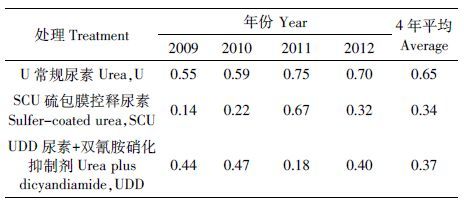文章信息
- 朱永昶, 李玉娥, 秦晓波, 段智源, 万运帆, 周伟平, 王斌, 何佳男
- ZHU Yong-chang, LI Yu-e, QIN Xiao-bo, DUAN Zhi-yuan, WAN Yun-fan, ZHOU Wei-ping, WANG Bin, HE Jia-nan
- 控释肥和硝化抑制剂对华北春玉米N2O排放的影响
- Effects of controlled release fertilizer and nitrification inhibitor additions on nitrous oxide emissions from spring maize field in Northern China
- 农业环境科学学报, 2016, 35(7): 1421-1428
- Journal of Agro-Environment Science, 2016, 35(7): 1421-1428
- http://dx.doi.org/10.11654/jaes.2016.07.027
文章历史
- 收稿日期: 2016-01-31
2. 福建省气象科学研究所, 福州 350001 ;
3. 海南省气象科学研究所, 海口 570203 ;
4. 福建师范大学地理科学学院, 福州 350007
2. Fujian Institute of Meteorological Science, Fuzhou 350001, China ;
3. Hainan Institute of Meteorological Science, Haikou 570203, China ;
4. College of Geographical Sciences, Fujian Normal University, Fuzhou 350007, China
2011 年,大气中的氧化亚氮(N2O)浓度已达到324 nL·L-1,约超过工业化前浓度水平的20%[1]。N2O是京都议定书规定的6 种温室气体之一,其100 年的全球增温潜势为CO2的265 倍,在大气中存活寿命约为131 年[1],并且对臭氧层具有破坏作用[2]。耕地土壤是大气中N2O 的主要排放源[3],肥料的施用是控制土壤N2O 排放的关键因素[4],同时亦对作物产量有决定性作用。玉米是重要的食品、饲料和工业原料[5],我国玉米产量约占谷物总产量的33%[6]。因此,玉米生产过程中所产生的N2O 排放不容忽视。研究既能增产又能减排的肥料管理措施对我国的粮食安全和农业可持续发展具有重要意义。
硝化抑制剂双氰胺(Dicyandiamide,DCD)可以抑制土壤中硝化微生物的活性,从而减少N2O 的排放[7]。DCD 具有弱挥发性、降解完全性等优点[8]。目前关于DCD 对N2O 排放的影响研究多集中在草地[9-11]、小麦[12-13]、水稻[14-15]和稻-麦轮作等系统[16-17],针对春玉米的研究较少。控释肥养分的供应与植物的需求基本一致,在满足植物整个生长季对养分的需求的同时可防止土壤中有效氮过量[18]。但由于气候、土壤特性和施肥方式等因素的差异,控释肥对N2O 的减排效果并不确定,有的研究认为控释肥可以降低N2O 排放[19-20],有的则相反[21-22]。
本文在总结前人研究的基础上,采用自动静态箱-气相色谱法对华北地区春玉米温室气体排放进行监测,明确温度、水分等环境因素对华北地区春玉米N2O 排放的影响,综合评价硫包膜控释肥和DCD 施用对华北地区春玉米的减排和增产效益。
1 材料与方法 1.1 试验设计2009—2012 年在山西省晋中市榆次区张庆乡演武村(112º51'E,37º38'N,海拔789 m),连续4 年监测不同肥料处理春玉米生长季内的N2O 排放通量。该地区为暖温带半湿润大陆性季风气候,年日照时数2662h,辐射总量545~581 kJ·cm-3,年平均气温9.8 ℃,降水量418~483 mm,降水主要集中于夏季6—8 月。土壤为黏壤土,于2009年测得其理化性质(表 1)。
田间试验共设置4 个施肥处理。不施肥对照(CK);尿素(U);硫包膜控释尿素(SCU);尿素+双氰胺(占总氮量10%)(UDD)。SCU 为汉枫牌,其养分释放类型为S 型。DCD 由中科院沈阳应用生态研究所提供。施肥方案见表 2,施肥在玉米行间进行,方式为沟施覆盖,沟深及沟宽均为10 cm。每个处理设3 个重复,随机区组排列,小区面积20 m2,间隔带1.5 m,各小区在方向上无差别。除自然降水外,每年于播种前和追肥后进行两次灌溉(2012 年追肥后未进行灌溉),灌溉量为每次700 m3·hm-2。春玉米品种为农华101。其他田间管理遵循当地农民习惯。
在各个小区中央选择距离作物行10 cm、覆盖施肥沟的面积为0.49 m2的区Ⅱ,作为N2O排放监测区Ⅱ。
1.2 采样及测定方法应用本课题组自主研发的温室气体自动采样系统监测春玉米生长季内土壤N2O 排放通量,Liu 等[23]对该系统进行了详尽的介绍。该系统分为田间采样系统和温室气体测定系统两部分。田间采样系统主体为可自动开闭的采样箱,采样箱长、宽、高分别为70、70、140 cm,为角钢骨架,四壁和顶部为透明聚碳酸酯板,底部开放。为保证气密性,箱体顶部与底部均贴有密封条且底部四角可插入土壤中。为了减小箱体的影响,采样箱在不采气时呈开放状态。箱内有风扇以在箱体封闭时混匀箱内气体。采样箱每隔3 h 进行一次气体采样,每天8 次,每次24 min,气样经由特氟龙管泵入气相色谱仪中分析其浓度。温室气体测定系统主体为气相色谱仪(HP5890Ⅱ,Agilent,USA),色谱分析柱为Porapak Q填充柱,柱温为70 ℃。对N2O 的检测采用电子捕获检测器(Electron capture detector,ECD),工作温度为330 ℃,载气为高纯氮气(99.999%),流量为20 mL·min-1。
采用温度传感器(18B20,DALLAS,USA)测定5cm 处的土壤温度。采用湿度传感器(EC-5,DecagonDevices,USA)测定10 cm 处的土壤体积含水率,土壤含水孔隙率(Water-filled pore space,WFPS)采用李超等[24]给出的方法计算。
于各年生长季内用“S”型取样法每隔10 d取各小区0~20 cm 土样,过2 mm 筛混匀后,取10 g加入50 mL、2 mol·L-1的KCl 溶液振荡得浸提液,采用流动分析仪(San Plus System,SKALAR,the Netherlands)分析其中NH4-+N 和NO3- -N 含量,降水和灌溉后视情况加测。
每年收获玉米后,在各试验小区内选取不靠边界的3 个4 m2区域作为测产区,人工收获玉米果实,脱粒、风干后测定玉米产量。
1.3 数据分析N2O 排放通量参照谢军飞等[25]给出的公式计算:
式中:F为N2O 排放通量,mg·m-2·h-1,正值、负值分别表示排放和吸收;m1 和m2 分别为静态箱关闭前、后N2O 的质量,g;A 为采样箱地面面积,即0.49 m2;C1和C2分别为静态箱关闭前、后N2O的体积百分比浓度;V 为采样箱的体积;M0为N2O的摩尔质量,44 g·moL-1;T1和T2分别为静态箱关闭前、后的箱内温度,℃;t1和t2分别为采样箱关闭和开启时的时间。
N2O 的日排放通量平均值F1 根据当天测定的8个N2O 排放通量值得出,进而计算出当日的N2O-N排放量F0(mg·m-2·h-1),即:
在计算排放总量时,缺测值采用内插法补全。
根据IPCC(2006)[26]给出的定义,N2O 排放系数(Emission factor,EF)应用下式计算:
式中:En和E0分别指施加不同氮肥处理和未施加氮肥处理的N2O-N 排放总量;N 指各处理生长季内的总的氮肥施用量。
采用Microsoft Excel(V2007,Microsoft Coopera原tion,USA)以及IBM SPSS Statistics 20(IBM Coopera原tion,USA)软件的Pearson 相关分析和LSD 多重比较对数据进行分析处理,采用MATLAB R2014a(Math原Works Cooperation,USA)软件进行绘图。
2 结果与分析 2.1 N2O排放通量2009—2012 年各处理的田间N2O 排放通量呈相似的季节变化规律(图 1)。CK 处理的N2O 排放相对稳定。结合图 2分析可见,各施肥处理的N2O 排放通量峰值均在施肥后遇灌溉或较强降水天气时出现,且存在一定的滞后,此后N2O 排放通量迅速下降至0kgN·hm-2·d-1左右。除2011 年外,其余各生长季SCU和UDD 处理首次N2O 排放峰值出现的时间均晚于U处理。
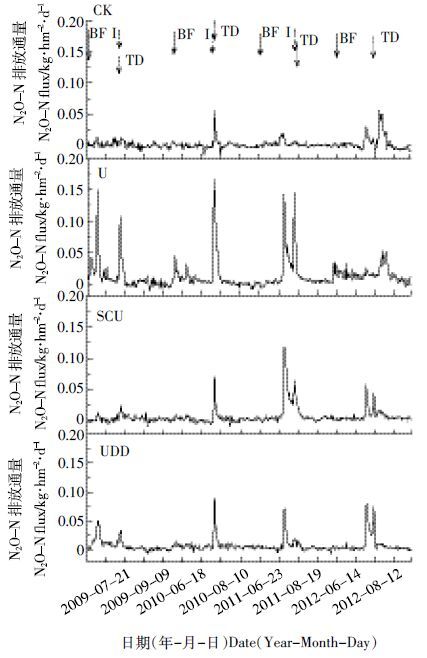
|
| 图 1 2009—2012 年不同处理的土壤N2O排放动态 Figure 1 Temporal variation of N2O fluxes in different treatments in 2009—2012 施用基肥(BF)、追肥(TD)和灌溉(I)下箭头分别指向施用基肥、追肥和灌溉的时间 |
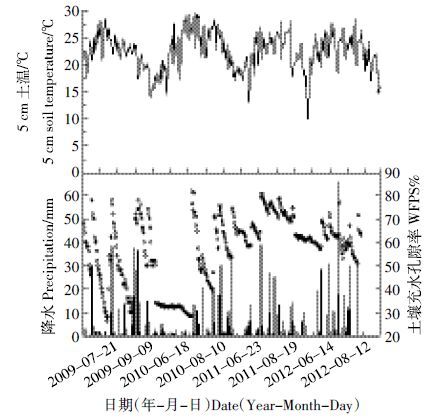
|
| 图 2 2009—2012 年不同处理的环境因素时间变化规律 Figure 2 Temporal variation of environmental factors in different treatments in 2009—2012 |
U 处理4 年的N2O 平均排放通量最高,为0.013kgN·hm-2·d-1,SCU 和UDD 处理4 年的N2O 平均排放通量相同,均为0.008 kgN·hm-2·d-1。CK 处理4 年的平均N2O 排放通量最低,为0.003 kgN·hm-2·d-1。SCU 和UDD 处理较U 处理起到了削减排放峰的作用,SCU 和UDD 处理4 年的N2O 排放峰平均峰值分别比U 处理低32.86%和16.69%,SCU 和UDD处理4 年排放高峰期间N2O 排放量也分别比U 处理低50.76%和51.72%。
2.2 N2O排放总量和排放系数除2009 年外,各施肥处理的N2O 排放总量均显著高于CK 处理,说明氮肥施用是影响N2O 排放总量的主要因素。2009—2012 年各生长季内,SCU 和UDD处理的累积N2O 排放量均低于U 处理。与U 处理(均值1 476.38 gN·hm-2)相比,SCU 和UDD 处理4 年的平均减排率分别为37.77%和33.39%(图 3),其中SCU 处理于2009、2010 和2012 年,UDD 处理于2010、2011 和2012 年N2O 减排效果显著(P <0.05)。
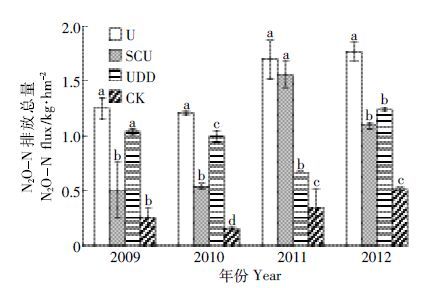
|
| 图 3 2009—2012 年各处理的春玉米生长期间N2O排放总量 Figure 3 Cumulative N2O emissionsin different fertilizer treatments 不同字母表示差异达显著水平P <0.05 |
SCU 和UDD 处理各生长季的N2O 排放系数均低于U 处理,仅为U 处理的52.31%和56.92%(表 3)。各处理4 年的N2O 排放系数均低于IPCC 缺省值(1%)[26]。
5cm土壤温度的变化范围在29.3~10 ℃之间,土壤N2 O 排放通量与5 cm 土壤温度呈极显著相关(r=0.136,n=1684,P >0.01)。各生长季内的累计降水量分别为347.7、226.4、229.1、344.7 mm,降水主要集中在6—8 月,占生长季总降水量的76.5%~95.1%。土壤充水孔隙率受降水和灌溉的影响,其变化范围为26.1%~82%(图 2),土壤N2O 排放通量与WFPS 呈极显著相关(r=0.217,n=1684,P >0.01)。N2O 排放峰值均在施肥后伴随WFPS 的高值出现,之后随WFPS 的下降而下降。
2.4 各施肥处理产量对比作物产量会受到气候和施肥等因素的影响。2009—2012 年各施肥处理的产量均显著高于CK 处理(图 4)。SCU 和UDD 处理的产量均较U 处理(平均产量11.14 t·hm-2)有所增加,4年的平均增产率分别为16.04%和6.35%。SCU 处理于2009 和2010 年,UDD处理于2009 年取得了显著的增产效果(P >0.05)。
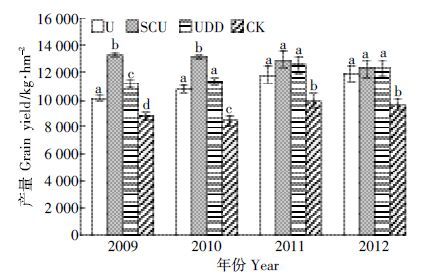
|
| 图 4 2009—2012 年各处理产量 Figure 4 Grain yields in different fertilizer treatments 不同小写字母表示差异达显著水平P <0.05 |
作为硝化作用的副产物和反硝化作用的中间产物,氧化亚氮主要由土壤中的微生物产生并释放到大气中[26]。活性氮(Reactive N,Nr)的可利用性是土壤中N2O 排放的主要驱动因素,肥料的施用是决定土壤N2O排放的关键因素。提高肥料的利用率是减少土壤中N2O 排放和增产的关键。相关研究表明,物理包膜可以控制尿素的释放速率,从而使尿素的释放与作物的需求同步,减少淋溶和气态氮素损失,提高作物的氮素利用率,起到增产和减排N2O 的效果[27-28]。包膜控释尿素的作用效果会受到气候、土壤特性和施肥方式等因素的影响。Jiang 等[21]在南京的研究表明,硫包膜控释尿素处理较常规尿素处理并未减排N2O,这可能是由于其施肥后遇到了较强降水过程等因素导致的。本研究中SCU 处理较U 处理连续4 年降低了N2O 季节排放总量(图 3),同时增加了各个生长季的作物产量(图 4),其原因是物理包膜使得尿素的释放与作物的需求同步,而尿素中加入硫还可提高作物生物固氮能力,平均提高氮肥利用率19.6%[29],在增加作物产量的同时减少N2O 的排放。
较之U 处理,UDD 处理在4 个生长季内均取得了减排和增产效果(图 3 和图 4)。这是因为硝化抑制剂可以抑制硝化作用,并减少氮素的淋溶,提高氮素利用率,从而减少土壤中N2O 的排放[30],提高作物产量。Ding 等[31]在封丘的研究表明双氰胺可以减少玉米季N2O 排放的39.0%,增产14.2%。Akiyama 等[30]通过meta 分析研究发现双氰胺可以减少旱地N2O 排放的25%。本研究中UDD 处理较U 处理四年平均N2O 排放减少了33.39%,减排效果高于此水平。
3.2 水热条件对春玉米N2O 排放的影响土壤中的水分会影响NH4+、NO3-和O2 等溶质的迁移、浓度及其对微生物的有效性,还会影响N2O 向大气的排放[32]。由于气候条件和土壤理化性质不同,已有研究结果也不尽相同。郑循华等[33]对太湖地区稻麦轮作系统的研究发现土壤湿度为84%~86%WFPS时N2O 排放量最大,而梁东丽等[34]对黄土高原玉米的研究结果表明土壤湿度为70%WFPS 时土壤N2O 排放通量达到最强。
本研究以10%WFPS 为间隔,计算各处理不同WFPS 范围内N2O 排放通量置信度为95%的置信区间(图 5a)。各处理N2O 排放通量大致随WFPS 增大而增加,U 和UDD 处理在WFPS>70%的范围N2O 排放通量最大,SCU、CK 处理在60%~70%WFPS 的范围N2O 排放通量最大。
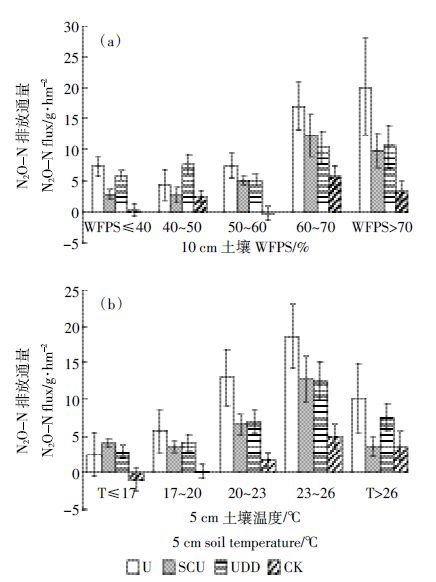
|
| 图 5 各处理10 cm土壤WFPS 以及5 cm 土温范围内的N2O 排放通量(95%置信区间) Figure 5 Emissions of N2O from soil under different soil temperature ranges at 5 cm depth and soil WFPS in 10 cm depth with ranges of 95%CⅠ |
土壤中N2O 的排放通量与土壤铵态氮含量呈极显著正相关,而与土壤硝态氮含量无显著相关关系(表 4),说明该系统中的土壤N2O 排放主要来自硝化作用。但在较强降水或灌溉后土壤湿度较大时,反硝化作用也可能处于主导地位[36]。各处理均在土壤湿度>20%WFPS 时产生N2O 正排放(图 6),可能是因为在此之前底物的扩散和水分的可利用性均受到限制,抑制了微生物的活性。各处理的N2O 排放通量大致随WFPS 的增大而增加,其N2 O 排放通量的较大值均在WFPS>60%时出现。这可能是由于在WFPS约60%时因反应基质和O2等的溶解受限,此时占主导地位的硝化作用的速率受到限制,而在WFPS 达到60%之后则不受限制[36],故产生较多的N2O 排放。当WFPS 为60%~70%时,参照Bateman 等[37]提出的概念模型,在此范围内可能出现硝化-反硝化作用的最适值。此时,由于适宜的土壤水分状况使得硝化作用在较干处以及土壤团聚体的外部等好氧的区Ⅱ内发生,反硝化作用在土壤较湿处和土壤团聚体内部等厌氧的区Ⅱ发生,达到了一个硝化、反硝化共同作用的最适值,故在干、湿界面处产生较多的N2O 排放[38]。在WFPS>70%时,反硝化作用可产生较大的N2O 排放。
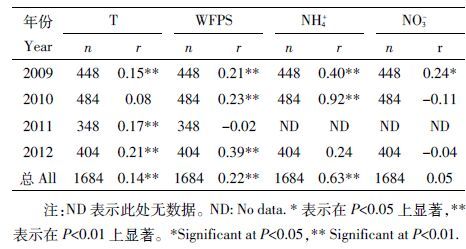
|

|
| 图 6 N2O排放通量与5 cm土温以及10 cm 土壤WFPS 的关系 Figure 6 Relationship between N2O-N flux and soil temperature at 5 cm soil depth and soil WFPS in 10 cm soil (a)(b)(c)和(d)分别表示CK、U、SCU和UDD处理 |
温度是影响土壤N2O 排放的重要因素[39]。本研究中,不同处理下N2O 日排放通量与土壤温度呈极显著相关(P >0.01),说明温度对该系统土壤N2O 排放有重要影响。本研究以3 ℃为间隔,求各处理5 cm土壤温度范围内N2O 排放通量置信度为95%的置信区间(图 5b),各处理土壤N2O 排放通量的最大值均出现在23~26 ℃范围内,且以此为界呈先上升,后下降的趋势。
土壤中N2O 的产生过程受到土壤温度和湿度的综合影响,各处理的N2O 排放通量较大值均出现在5cm土壤温度>20 ℃,10 cm 土壤湿度>60%WFPS 的范围内(图 6)。
4 结论(1) 土壤中N2O 的排放与土壤WFPS、土壤温度和土壤铵态氮含量呈极显著正相关。土壤N2O 排放通量较大值均分布在10 cm 土壤湿度>60%WFPS,5cm土壤温度>20 ℃的范围内。
(2) 硫包膜控释尿素和添加硝化抑制剂双氰胺在4 个生长季内均起到了减排N2O 和增加产量效果,其减排率达30%以上,增产率分别为16.04%和6.35%,且减排效果具有一定的持续性,但增产效果却逐年下降。
| [1] | IPCC. Climate Change 2013:The Physical Science Basis. Contribution of working group I to the fifth assessment report of the intergovernmental panel on climate change[R]. UK:Cambridge University Press, 2013. |
| [2] | UNEP 2013. Drawing down N2O to protect climate and the ozone layer:A UNEP synthesis report[R]. United Nations Environment Programme (UNEP), Nairobi, Kenya. |
| [3] | Syakila A, Kroeze C. The global nitrous oxide budget revisited[J]. Greenhouse Gas Measurement and Management , 2011, 1 (1) : 17–26. |
| [4] | Butterbach-Bahl K, Baggs E M, Dannenmann M, et al. Nitrous oxide emissions from soils:How well do we understand the processes and their controls?[J]. Philosophical Transactions of the Royal Society of London B:Biological Sciences , 2013, 368 (1621) : 91–97. |
| [5] | 王宜伦, 卢艳丽, 刘举, 等. 专用缓释肥对夏玉米产量及养分吸收利用的影响[J]. 中国土壤与肥料 , 2015 (1) : 29–32. WANG Yi-lun, LU Yan-li, LIU Ju, et al. Effects of special slow-release fe rtilizer on yield and nutrient absorption and utilization of summer maize[J]. Soil and Fertilizer Science in China , 2015 (1) : 29–32. |
| [6] | 李明. 世界玉米生产回顾和展望[J]. 玉米科学 , 2010, 18 (3) : 165–169. LI Ming. Review and prospect of maize production in the world[J]. Jour nal of Maize Sciences , 2010, 18 (3) : 165–169. |
| [7] | 戴宇, 贺纪正, 沈菊培. 双氰胺在农业生态系统中的应用效果及其影响因素[J]. 应用生态学报 , 2014, 25 (1) : 279–286. DAI Yu, HE Ji-zheng, SHEN Ju-pei. Effects and influence factors of dicyandiamide(DCD)application in agricultural ecosystem[J]. Chinese Jo urnal of Applied Ecology , 2014, 25 (1) : 279–286. |
| [8] | 李香兰, 徐华, 蔡祖聪. 氢醌, 双氰胺组合影响稻田甲烷和氧化亚氮排放研究进展[J]. 土壤学报 , 2009 (5) : 917–924. LI Xiang-lan, XU Hua, CAI Zu-cong. Effect of combined use of hydro quinone and dicyandiamide on CH4 and N2O emissions from rice paddy field:A review[J]. Acta Pedologica Sinica , 2009 (5) : 917–924. |
| [9] | Di H J, Cameron K C. Mitigation of nitrous oxide emissions in spray-irrigated grazed grassland by treating the soil with dicyandiamide, anitri fication inhibitor[J]. Soil Use and Management , 2003, 19 (4) : 284–290. |
| [10] | Di H J, Cameron K C. The use of a nitrification inhibitor, dicyandi amide(DCD), to decrease nitrate leaching and nitrous oxide emissions in a simulated grazed and irrigated grassland[J]. Soil Use and Man agement , 2002, 18 (4) : 395–403. |
| [11] | Merino P, Estavillo J M, Graciolli L A, et al. Mitigation of N2O emis sions from grassland by nitrification inhibitor and Actilith F2 applied with fertilizer and cattle slurry[J]. Soil Use and Management , 2002, 18 (2) : 135–141. |
| [12] | Bhatia A, Sasmal S, Jain N, et al. Mitigating nitrous oxide emission fr om soil under conventional and no-tillage in wheat using nitrification inhibitors[J]. Agriculture, Ecosystems & Environment , 2010, 136 (3) : 247–253. |
| [13] | Majumdar D, Pathak H, Kumar S, et al. Nitrous oxide emission from a sandy loam Inceptisol under irrigated wheat in India as influenced by different nitrification inhibitors[J]. Agriculture, Ecosystems & Environ ment , 2002, 91 (1) : 283–293. |
| [14] | Majumdar D, Kumar S, Pathak H, et al. Reducing nitrous oxide emission from an irrigated rice field of North India with nitrification in hibitors[J]. Agriculture, Ecosystems & Environment , 2000, 81 (3) : 163–169. |
| [15] | Xu X K, Boeckx P, Van C O, et al. Urease and nitrification inhibitors to reduce emissions of CH4 and N2O in rice production[J]. Nutrient Cy cling in Agroecosystems , 2002, 64 (1/2) : 203–211. |
| [16] | Malla G, Bhatia A, Pathak H, et al. Mitigating nitrous oxide and methane emissions from soil in rice-wheat system of the Indo-Gangetic plain with nitrification and urease inhibitors[J]. Chemosphere , 2005, 58 (2) : 141–147. |
| [17] | Boeckx P, Xu X K, Van C O. Mitigation of N2O and CH4 emission from rice and wheat cropping systems using dicyandiamide and hydro quinone[J]. Nutrient Cycling in Agroecosystems , 2005, 72 (1) : 41–49. |
| [18] | 张婧, 夏光利, 李虎, 等. 一次性施肥技术对冬小麦/夏玉米轮作系统土壤N2O排放的影响[J]. 农业环境科学学报 , 2016, 35 (1) : 195–204. ZHANG Jing, XIA Guang-li, LI hu, et al. Effect of single basal fertil ization on N2O emissions in wheat and maize rotation systerm[J]. Jour nal of Agro-Environment Science , 2016, 35 (1) : 195–204. |
| [19] | Yang L, Wang L G, Li H, et al. Impacts of fertilization alternatives and crop straw incorporation on N2O emissions from a spring maize field in Northeastern China[J]. Journal of Integrative Agriculture , 2014, 13 (4) : 881–892. |
| [20] | 纪洋, 张晓艳, 马静, 等. 控释肥及其与尿素配合施用对水稻生长期N2O排放的影响[J]. 应用生态学报 , 2011, 22 (8) : 2031–2037. JI Yang, ZHANG Xiao-yan, MA Jing, et al. Effects of applying con trolled-release fertilizer and its combination with urea on nitrous oxide emission during rice growth period[J]. Chinese Journal of Applied E cology , 2011, 22 (8) : 2031–2037. |
| [21] | Jiang J Y, Hu Z H, Sun W J, et al. Nitrous oxide emissions from Chi nese cropland fertilized with a range of slow-release nitrogen com pounds[J]. Agriculture, Ecosystems & Environment , 2010, 135 (3) : 216–225. |
| [22] | Chu H Y, Hosen Y, Yagi K. NO, N2O, CH4 and CO2 fluxes in winter bar ley field of Japanese Andisol as affected by N fertilizer management[J]. Soil Biology and Biochemistry , 2007, 39 (1) : 330–339. |
| [23] | Liu Y T, Li Y E, Wan Y F, et al. Nitrous oxide emissions from irrigated and fertilized spring maize in semi-arid Northern China[J]. Agriculture, Ecosystems & Environment , 2011, 141 (3) : 287–295. |
| [24] | 李超, 万运帆, 李玉娥, 等. 春玉米田施用双氰胺和硫包衣尿素的节本减排效果分析[J]. 中国农业气象 , 2013, 34 (5) : 526–531. LI Chao, WAN Yun-fan, LI Yu-e, et al. Effect of Dicyandiamide and sulfur coated urea on saving cost and N2O emission reduction in spring corn field[J]. Chinese Journal of Agrometeorology , 2013, 34 (5) : 526–531. |
| [25] | 谢军飞, 李玉娥. 土壤温度对北京旱地农田N2O排放的影响[J]. 中国农业气象 , 2005, 26 (1) : 7–10. XIE Jun-fei, LI Yu-e. Effect of soil temperature on N2O emission in upland farm of Beijing[J]. Chinese Journal of Agrometeorology , 2005, 26 (1) : 7–10. |
| [26] | Klein C D, Novoa R S A, Ogle S, et al. N2O emissions from managed soils, and CO2 emissions from lime and urea application//2006 IPCC Guidelines for National Greenhouse Gas Inventories, Vol 4:Agricul ture, Forestry and Other Land Use[M]. Kanagawa, Japan: Institute for Global Environmental Strategies (IGES), 2006 : 5 -11. |
| [27] | 胡腾, 同延安, 高鹏程, 等. 黄土高原南部旱地冬小麦生长期N2O排放特征与基于优化施氮的减排方法研究[J]. 中国生态农业学报 , 2014, 22 (9) : 1038–1046. HU Teng, TONG Yan-an, GAO Peng-cheng, et al. N2O emission char acteristics and mitigation methods in South Loess Plateau under rainfed winter wheat conditions[J]. Chinese Journal of Eco-Agriculture , 2014, 22 (9) : 1038–1046. |
| [28] | 纪洋, 刘刚, 马静, 等. 控释肥施用对小麦生长期N2O排放的影响[J]. 土壤学报 , 2012, 49 (3) : 526–534. JI Yang, LIU Gang, MA Jing, et al. Effect of controlled-release fertiliz er (CRF)on nitrous oxide emission during the wheat growing period[J]. Acta Pedologica Sinica , 2012, 49 (3) : 526–534. |
| [29] | 赵秉强, 许秀成, 武志杰, 等. 新型肥料[M]. 北京: 科学出版社, 2013 : 25 . ZHAO Bing-qiang, XU Xiu-cheng, WU Zhi-jie, et al. New fertilizer[M]. Beijing: Science Press, 2013 : 25 . |
| [30] | Akiyama H, Yan X Y, Yagi K. Evaluation of effectiveness of enhancedefficiency fertilizers as mitigation options for N2O and NO emissions fr om agricultural soils:Meta-analysis[J]. Global Change Biology , 2010, 16 (6) : 1837–1846. |
| [31] | Ding W X, Yu H Y, Cai Z C. Impact of urease and nitrification in hibitors on nitrous oxide emissions from fluvo-aquic soil in the North China Plain[J]. Biology & Fertility of Soils , 2011, 47 (1) : 91–99. |
| [32] | 蔡祖聪, 徐华, 马静. 稻田生态系统CH4和N2O排放[M]. 合肥: 中国科学技术大学出版社, 2009 : 157 -184. CAI Zu-cong, XU Hua, MA Jing. CH4 and N2O emission from rice-based ecosystems[M]. Hefei: University of Science and Technology of China Press, 2009 : 157 -184. |
| [33] | 郑循华, 王明星, 王跃思, 等. 稻麦轮作生态系统中土壤湿度对N2O产生与排放的影响[J]. 应用生态学报 , 1996, 7 (3) : 273–279. ZHENG Xun-hua, WANG Ming-xing, WANG Yue-si, et al. Impact of soil humidity on N2O production and emission from a rice-wheat rota tion ecosystem[J]. Chinese Journal of Applied Ecology , 1996, 7 (3) : 273–279. |
| [34] | 梁东丽, 同延安, EmterydO, 等. 灌溉和降水对旱地土壤N2O气态损失的影响[J]. 植物营养与肥料学报 , 2002, 8 (3) : 298–302. LIANG Dong-li, TONG Yan-an, Emteryd O, et al. Effect of irrigation and rainfall on the N2O losses in dry land[J]. Plant Nutrition and Fertil izer Science , 2002, 8 (3) : 298–302. |
| [35] | 黄国宏, 陈冠雄, 韩冰, 等. 土壤含水量与N2O产生途径研究[J]. 应用生态学报 , 1999, 10 (1) : 53–56. HUANG Guo-hong, CHEN Guan-xiong, HAN Bing, et al. Relationship between soil water content and N2O production[J]. Chinese Journal of applied Ecology , 1999, 10 (1) : 53–56. |
| [36] | Parton W J, Mosier A R, Ojima D S, et al. Generalized model for N2 and N2O production from nitrification and denitrification[J]. Global Biogeo chemical Cycles , 1996, 10 (3) : 401–412. |
| [37] | Bateman E J, Baggs E M. Contributions of nitrification and denitrifica tion to N2O emissions from soils at different water-filled pore space[J]. Biology and Fertility of Soils , 2005, 41 (6) : 379–388. |
| [38] | Wrage N, Velthof G L, Van Beusichem M L, et al. Role of nitrifier deni trification in the production of nitrous oxide[J]. Soil Biology and Bio chemistry , 2001, 33 (12) : 1723–1732. |
| [39] | 郑循华, 王明星, 王跃思, 等. 温度对农田N2O产生与排放的影响[J]. 环境科学 , 1997, 5 : 1–5. ZHENG Xun-hua, WANG Ming-xing, WANG Yue-si, et al. Impacts of temperature on N2O production and emission[J]. Environmental Sci ence , 1997, 5 : 1–5. |
 2016, Vol. 35
2016, Vol. 35










